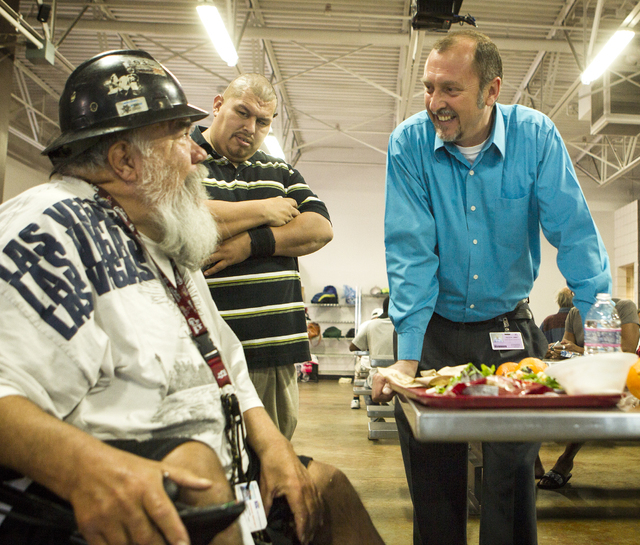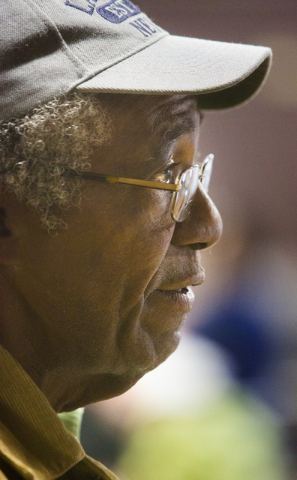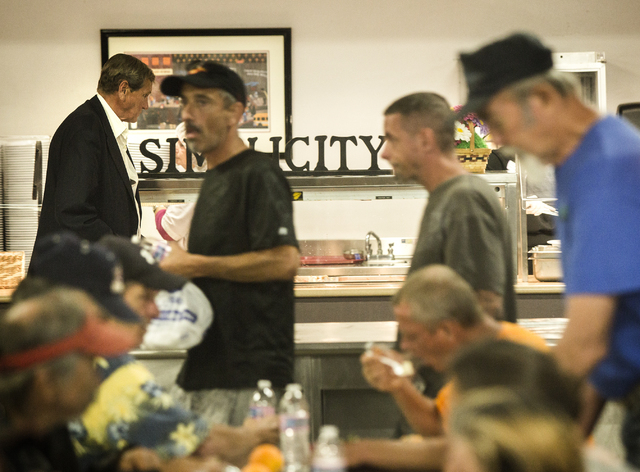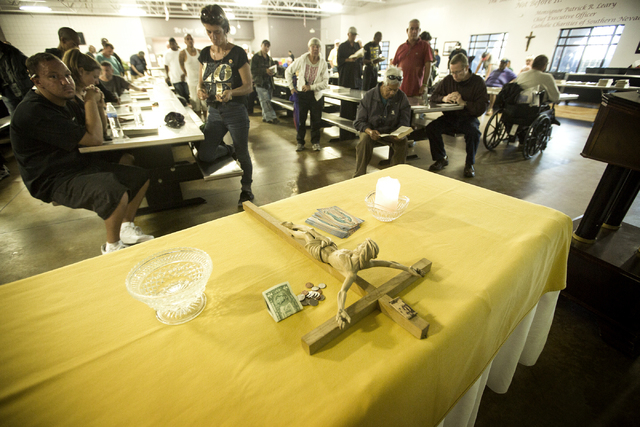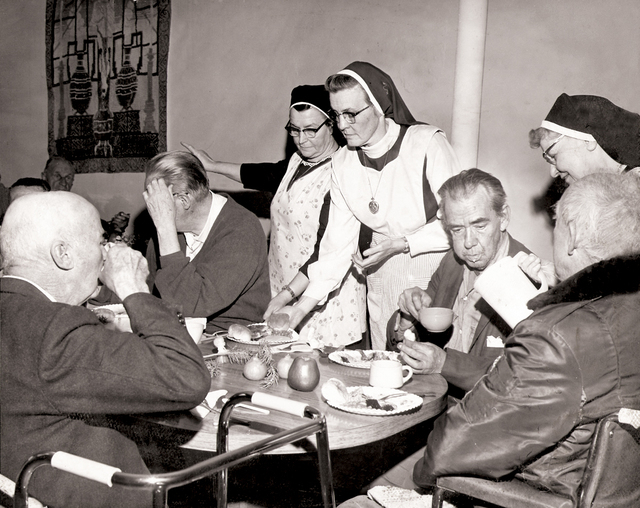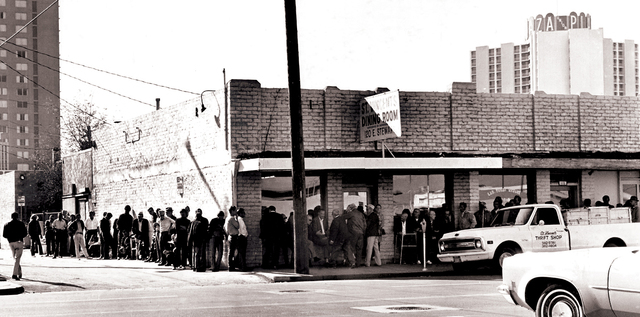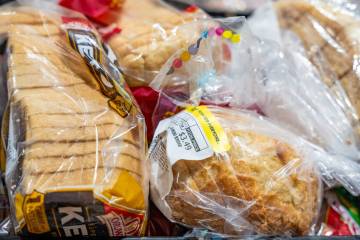St. Vincent Lied Dining Facility celebrates 50 years of serving meals, dignity
Today’s entree is a broiled salmon fillet served with mustard seed-speckled potato salad, root vegetables braised in red wine, a mixed greens salad with mesclun, fresh fruit and a drink.
Ten or 12 bucks, easy, at your favorite casino coffee shop and that’s without the tip. But at the St. Vincent Lied Dining Facility on a recent midday morning, the meal — served on real dinnerware and artfully arranged in a fashion that makes it look as good as it tastes — cost exactly nothing.
That’s because it was the daily entree — at least for the first 400 diners; after that, it’s chef’s choice — at the dining room’s free daily community meal, where homeless, low-income and just financially strapped Southern Nevadans gather for a nutritious meal, a bit of company and maybe even a lead on an agency or service that might help them get back on their feet.
And along with all of that tasty, imaginatively conceived and well-prepared food, the St. Vincent Lied Dining Facility serves its clients something even more satisfying: Dignity.
This year, the St. Vincent Lied Dining Facility, operated by Catholic Charities of Southern Nevada, celebrates 50 years of feeding Southern Nevada’s homeless and hungry in a way that belies, in both philosophy and practice, the stereotypical notion of a “soup kitchen.” The dining room — the current incarnation of which opened in 1998 — is clean and airy, resembling a modernish, slightly retro version of a high school cafeteria, and food is served on real dishes by volunteers working from behind cafeterialike stations.
Granted, it wasn’t always that way. Executive chef Juan Carlos Penate remembers when food was served from a window on plates with TV dinner-type compartments. Entrees also used to tend toward the caloric, based on the not-unreasonable assumption that the meal some clients ate there would be the only one they’d have all day.
Penate came to Catholic Charities with a resume that includes positions in hotels and fine dining establishments back East. When the Italian restaurants in Gloucester, Mass., that he oversaw were closed — a victim, he says, of the owners’ divorce — he set off on a cross-country drive, figuring on returning to California, where he had grown up and where he still has family.
During a stop in Las Vegas, while exploring the city, Penate happened to drive downtown and noticed rows of tents set up on the sidewalk on the streets around Foremaster Lane.
“It was like a tent campground,” Penate says. “I realized they were homeless. I was, like, ‘What is this?’ It affected me so much. The first thing I said, was, ‘I wish there was something I could do to help those people.’ ”
Penate got a job at the Silverton, and when the executive chef’s position at Catholic Charities opened, a fellow chef suggested that Penate apply. He did, and was surprised to see exactly where the St. Vincent Lied Dining Facility was.
“Sure enough, I was in front of the place where I had driven by,” Penate says. “I remembered seeing all those people on the sidewalk, sleeping, and saying those words — ‘I wish there was something I could do’ — and, five years later, here I am.”
The original dining room was opened in 1965 by the Rev. Charles Shallow in a building on E Street. Several moves followed — for a time, the dining room operated out of St. James Catholic Church, then on McWilliams Avenue — before moving to its current location at 1502 N. Main St. on the Catholic Charities of Southern Nevada campus.
From 8 to 9 a.m. each morning, the dining room serves a $4 breakfast — on a recent morning, the menu included scrambled eggs, seasoned potatoes, sausage, juice and coffee — and, from 10 a.m. to 11 a.m., the free community meal (another low-cost lunch/dinner service follows from noon to 4 p.m.). The dining room’s menus are crafted almost entirely on the basis of donations of food the facility receives.
That hotel-quality salmon dinner, for instance? Everything but the salad dressing was donated by the Sands Expo and Convention Center, sous chef Paul Munson says.
Penate says donations come from valley supermarkets, hotels, restaurants and Three Square food bank. Because much of the donated food is perishable, Penate and his staff are adept at making last-minute menu changes and at finding ways to incorporate donated goods into menus in creative ways.
That’s one difference between running the St. Vincent Lied dining room and running a restaurant kitchen, Penate says.
“I cannot afford to buy expensive chocolate for the dessert from Switzerland or Belgium,” he says. “I’ve got to work with what comes though my back door and turn it into a nice luncheon.”
“It is an adjustment, but you’ve got to work with what you have. We’re grateful for the community and such great partners like Three Square food bank.”
Another difference is the lean budget — about $1,200 a week — Penate has to run the dining room. In comparison, he says, a restaurant that serves as many meals as the St. Vincent Lied dining room does would have a budget about 10 times that of his kitchen.
And manpower?
“Here, we serve about 1,200 meals a day with a staff of basically three of us (chefs) and two dishwashers. Everybody else is volunteers,” Penate says. “You go to a hotel that serves that many, they’d have an army.”
Besides serving walk-in diners in the dining facility, Penate’s two kitchens serve clients in Catholic Charity’s residential programs and prepare Meals on Wheels dinners for seniors and meals for women and children at The Shade Tree shelter.
So it’s a function of both philosophy and economics that Penate and his staff make full use of every ingredient they have in ways that aren’t just economical but make for great-tasting dishes, too.
For example, the kitchen makes its own gravies and stock, and ingredients left over from the preparation of today’s dishes will find their way into tomorrow’s. In that way, Munson says, “we’re doing a lot of things fine dining restaurants would do on the Strip. We don’t approach it as just institutional (food).”
On this particular day, for example, behind-the-scenes kitchen activity includes sauce for mac and cheese cooking in a steam kettle, turkey legs being cooked and divided for tomorrow’s meal, tomatoes being sliced for Caprese salad, and hundreds of pecan pies and tarts cooling on racks.
Do clients appreciate the effort? Sometimes. Take the woman (who declines to offer her name) who says she’s been in Las Vegas for about a year and stops in every day for a meal. She judges the day’s salmon entree “all right. Pretty good.”
“Not like a restaurant,” she adds, “but enough to keep somebody alive and going.”
Luis Sanchez would disagree. He’s staying at Catholic Charities’ shelter, dines at the facility every day, and is, he says, proof that “if it can happen to me, it can happen to anybody.”
Sanchez says he holds three degrees, including a master’s in business administration, and worked in food safety for a California produce company before moving to Las Vegas, where a dispute with his family left him with no money.
Being able to come to the dining room for a good meal every day “helps my morale,” Sanchez says.
Kandy Miller, the dining room’s manager, says that although some clients are homeless and live on the street, other patrons of the facility include homeless people who are staying with friends and people and seniors who have homes but whose retirement and support checks run out by the end of the month. That, she adds, is why the second half of each month tends to see the arrival of more diners.
But someone’s circumstances don’t matter, Miller says. “There’s acceptance and no judgment.”
John Rose, who says he dines at the facility “pretty often,” rates the day’s salmon dinner as very good.
Rose has diabetes, and complications from the disease have put him in a wheelchair.
“I did get disability from the government,” he says, “but after paying my rent, I’ve got no money left. I mean, I pretty much have no money left.”
Rose notes that the meals served at some shelters don’t always make for a diabetes-healthy diet.
“They feed you way too many starches, mostly potatoes and rice, which I can’t have,” he says. “In fact, I got diabetes being on the street, before I got my disability check. I was on the street 10 years.”
As Rose talks with visitors, Jimmy Rolson, Catholic Charities’ director of client operations, stops by to say hello.
“Where have you been? I haven’t seen you,” says Rolson, shaking Rose’s hand. Rolson explains later that he met Rose when Rose was on the street and Rolson was a case manager at Catholic Charities.
“I’m doing good. Doing good,” Rose tells Rolson. “As I was telling these guys, God is taking good care of me. You can’t ask more than that.”
It’s an illustration of another thing about the St. Vincent Lied Dining Facility: The dining room’s utility goes beyond the food it serves. It also offers Catholic Charities staff members the chance to touch base with clients or prospective clients, and direct newcomers to services they may not even realize are available in the community.
“It really opens the door for more resources for them, because we know what’s out there and they don’t,” Rolson says. “It could be housing. It could be our programs, or our resident work program, or the shelter. People may not even know about the shelter. They could be walking down the street and somebody says, ‘I’m going to eat at Catholic Charities. Do you want to go?’ ‘Yeah.’ And then they come here for the first time.”
Also important, Miller says, is that “this is where (diners) come to socialize. This is where they come and, just, someplace where they can relax and nobody judges them.”
Sure, the whiteboard at the entrance to the St. Vincent Lied Dining Facility lists the day’s menu. But Penate says the dining room serves its clients much more.
“It’s very thrilling to know we are helping our community,” Penate says.
“I’ve always said that if this was a for-profit business, it would be the perfect business, because our clients just keep increasing. I’d be happy to say that I no longer have to work here because we didn’t need it, but that’s almost impossible at the rate we’re going,”
“But,” Penate adds, “that would be nice.”
Contact reporter John Przybys at jprzybys@reviewjournal.com or 702-383-0280 or follow @JJPrzybys on Twitter.




